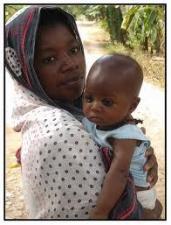15 Good Reasons To Spend More Money On Poor Moms
 New York Times journalists and best-selling authors Nicholas Kristof and Sheryl WuDunn are dead right when they say that real-life stories of individuals are much more powerful in their capacity to inspire people to act than mountains of data are.
New York Times journalists and best-selling authors Nicholas Kristof and Sheryl WuDunn are dead right when they say that real-life stories of individuals are much more powerful in their capacity to inspire people to act than mountains of data are.As a public speaking coach, I know the power of storytelling is unmatched as a way to get one’s message across.
But as I weep my way through Half The Sky, Kristof and WuDunn’s disturbing, shocking and yet doggedly hopeful book on the plight of women worldwide, I’ve also been moved by the duo’s well-researched statistics – they paint a compelling picture of a world still disgracefully imbalanced in favour of wealthy nations.
Here’s an AWR Index compiled with numbers drawn from the Half The Sky, chapters on maternal health:
1) Number of women who die in childbirth each minute: 1
2) Percentage of those deaths that occur in “poor” countries: 99
3) Number of maternal deaths annually per 100,000 live births in Ireland: 1
4) Number of maternal deaths annually per 100,000 live births in Sierre Leone: 2,100
5) Chances that a woman will die in childbirth sometime during her lifetime in Ireland: 1 in 47,600
6) Chances that a woman will die in childbirth sometime during her lifetime in Niger: 1 in 7
7) Amount the USA spends annually on maternal healthcare expressed as a percentage of the annual US military spend: 0.0005
8) Number of women annually who die as a result of unsafe abortions worldwide: 70,000
9) Number of women annually who suffer serious injuries as a result of unsafe abortions worldwide: 5,000,000
10) Estimated annual cost to care for the 5 million women who suffer serious injuries as a result of unsafe abortions worldwide: USD 750,000,000
11) World Bank estimate of the number of women who could be saved from death in childbirth for every 1,000 girls who receive one additional year of education: 2
12) Approximate factor by which Sri Lanka has reduced its number of annual maternal deaths over the last 50 years: 10*
13) Percentage reduction in a study of maternal childbirth deaths in Nepalese women who were given Vitamin A supplements during pregnancy: 40
14) Total amount spent on international development assistance worldwide for maternal and neonatal health in 2004: USD 530,000,000
15) One estimate of the additional annual cost to provide comprehensive maternal and newborn health to 95% of the world’s population expressed as a percentage of the amount spent worldwide on pet food: 22.5 **
Significantly, four of the eight United Nations Development Programme’s Millennium Goals adopted in 2000 and targeted to be achieved in 2015 apply directly to women and children. They are:
#2 Achieve universal primary education
#3 Promote gender equality and empower women
#4 Reduce child mortality
#5 Improve maternal health
These are admirable objectives, the achievement of which will no doubt create a better world for all of us. Some progress has been made, but we have a long, long way to go.
Stories touch our hearts. Those told in Half The Sky have the power to change your life, and set you on a path that will help all of us move closer to reaching the UNDP targets.
As for the numbers, well, they speak for themselves don’t they?
* i.e. to 58 maternal deaths per 100,000 live births from 550 maternal deaths per 100,000 live births
** i.e. the care estimate is USD 9,000,000,000; the amount spent annually on pet food worldwide is USD 40,000,000,000
Related links:
Half The Sky
United Nations Development Programme’s Millennium Goals
Between Life, Birth & Death